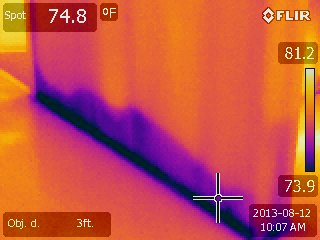How do I dry wet walls after a house flood? This is a question the team at I Find and Dry Leaks receives on a regular basis. The first step to treating water damage after a house flood or a broken water pipe is to identify where all of the moisture is. In many cases, you cannot see all of the water damage with the naked eye. Wet things like to be dry and dry things like to be wet. This is the first thing to keep in mind after a water damage event occurs in your Tampa Bay home or office. Water also travels and follows the path of least resistance. It often follows studs that are anchored into your concrete slab which are the base of walls built in your home. These studs act as a channel for the water to follow. For instance, a leaking plumbing line to the refrigerator caused the water damage shown in the pictures below. The water traveled underneath the wood flooring and along the walls. The bottom of the walls act like a sponge and soak up the water. We use an infrared camera to identify water damage and map the moisture in the home. Just because something may feel dry doesn’t necessarily mean it is dry. With the use of this infrared technology, we are able to see the water damage so that we can dry it effectively.
I Find and Dry Leaks carries the latest state of the art dry out equipment on the market today. We use dehumidifiers and fans as well as some specialty drying equipment to dry walls, ceilings and floors. By using this equipment we can save the home from the potential of mold, black mold and mildew. We are always available to handle any water damage emergency no matter what time of the day or night. Feel free to give us a call if you have any questions in regards to water damage or in regards to finding a hidden water leak.


